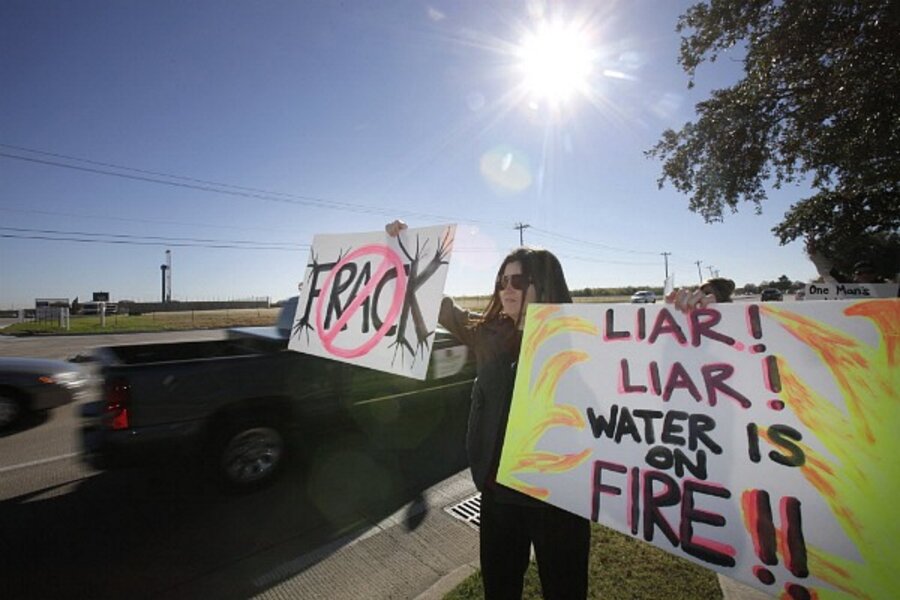New warning of poisonous chemicals in natural gas 'hydrofracking'
Loading...
Chemicals used to extract natural gas from vast areas of the United States include “extremely toxic substances, such as benzene and lead,” according to a new report released by members of the House Energy and Commerce Committee.
Twenty-nine of the chemicals are known or possible human carcinogens, regulated under the Safe Drinking Water Act for risks to human health or listed as hazardous air pollutants under the Clean Air Act, according to the report.
“This report shows that these companies are injecting millions of gallons of products that contain potentially hazardous chemicals, including known carcinogens,” said Rep. Henry Waxman (D) of California, senior Democrat on the committee.
Oil and gas industry officials deny that hydraulic fracturing – known as “hydrofracking” – is a threat to the environment or public health.
"This report uses the same sleight of hand deployed in the last report on diesel use – it compiles overall product volumes, not the volumes of the hazardous chemicals contained within those products," Matt Armstrong, an attorney representing companies involved in natural gas drilling, told the New York Times. "This generates big numbers but provides no context for the use of these chemicals over the many thousands of frac jobs that were conducted within the timeframe of the report."
Still, this latest evidence seems likely to accelerate study and possibly regulation of an industrial technique that has become increasingly controversial, particularly through the 2010 documentary film “Gasland.”
Fracking involves pumping a slurry of sand, water, and chemicals deep underground at high pressure – cracking open shale deposits and allowing the natural gas embedded there to emerge. The process has been hailed as a boon for US energy supplies and has boosted US natural-gas reserves in recent years.
But a growing number of residents in Texas, Pennsylvania, Colorado, and other states say the technique has fouled their drinking-water wells and even caused the tap water coming out of their faucets to smell like industrial chemicals.
As shown in “Gasland,” some people’s tap water has flared up when lit with a match.
Joining Rep. Waxman in releasing the report were Edward Markey of Massachusetts, senior Democrat on the Natural Resources Committee, and Diana DeGette of Colorado, senior Democrat on the oversight and investigations subcommittee. They had asked for the investigative report before Republicans took over the House in last November’s elections.
Among other things, the report finds:
• The 14 leading oil and gas service companies used more than 780 million gallons of hydraulic fracturing products, not including water added at the well site. Overall, the companies used more than 2,500 hydraulic fracturing products containing 750 different chemicals and other components.
• The components used in the hydraulic fracturing products ranged from generally harmless and common substances, such as salt and citric acid, to extremely toxic substances, such as benzene and lead. Some companies even used instant coffee and walnut hulls in their fracturing fluids.
• Between 2005 and 2009, the oil and gas service companies used hydraulic fracturing products containing 29 chemicals that are known or possible human carcinogens, regulated under the Safe Drinking Water Act (SDWA) for their risks to human health, or listed as hazardous air pollutants under the Clean Air Act.
• The BTEX compounds – benzene, toluene, xylene, and ethylbenzene – are SDWA contaminants and hazardous air pollutants. Benzene also is a known human carcinogen. The hydraulic fracturing companies injected 11.4 million gallons of products containing at least one BTEX chemical over the five-year period.
• Methanol, which was used in 342 hydraulic fracturing products, was the most widely used chemical between 2005 and 2009. The substance is a hazardous air pollutant and is on the candidate list for potential regulation under SDWA. Isopropyl alcohol, 2-butoxyethanol, and ethylene glycol were the other most widely used chemicals.
• Many of the hydraulic fracturing fluids contain chemical components that are listed as “proprietary” or “trade secret.” The companies used 94 million gallons of 279 products that contained at least one chemical or component that the manufacturers deemed proprietary or a trade secret. In many instances, the oil and gas service companies were unable to identify these “proprietary” chemicals, suggesting that the companies are injecting fluids containing chemicals that they themselves cannot identify.





